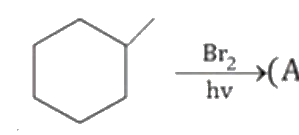Give the stereochemical structures of BandC.<br> 2,overset("Erythro-")underset((A))(3-"dibromobut ane") overset ("Nal/Acetone") rarr (B)overset("Cold alk")underset (KMnO_(4))rarr(C)
To solve the question regarding the stereochemical structures of compounds B and C derived from erythro-2,3-dibromobutane (compound A), we will follow these steps:
Step 1: Draw the structure of compound A (erythro-2,3-dibromobutane)
- Erythro-2,3-dibromobutane has two bromine atoms on the second and third carbon atoms, and since it is erythro, the bromine atoms are on the same side of the carbon chain.
- The structure can be represented as follows:
BrBr||H3C−C−CH−CH3||HH
Step 2: Identify the reaction of compound A with NaI in acetone
- The reaction of erythro-2,3-dibromobutane with NaI in acetone leads to an anti-elimination reaction, resulting in the formation of an alkene.
- The elimination occurs in such a way that the bromine atoms are removed from opposite sides, leading to the formation of a trans-alkene.
Step 3: Draw the structure of compound B (trans-alkene)
- The resulting alkene (compound B) will have the following structure:
HH C=CCH3CH3
Step 4: Identify the reaction of compound B with cold alcoholic KMnO4
- The cold alcoholic KMnO4 treatment leads to syn-dihydroxylation, where two hydroxyl (OH) groups are added to the same side of the double bond.
- This results in the formation of a cis-diol.
Step 5: Draw the structure of compound C (cis-diol)
- The resulting compound C will have the following structure, which is a racemic mixture of two enantiomers:
OHOH||H3C−C−CH−CH3||HH
Summary of Structures
- Compound B (trans-alkene):
HH C=CCH3CH3
- Compound C (cis-diol):
OHOH||H3C−C−CH−CH3||HH
- Erythro-2,3-dibromobutane has two bromine atoms on the second and third carbon atoms, and since it is erythro, the bromine atoms are on the same side of the carbon chain.
- The structure can be represented as follows:
- The reaction of erythro-2,3-dibromobutane with NaI in acetone leads to an anti-elimination reaction, resulting in the formation of an alkene.
- The elimination occurs in such a way that the bromine atoms are removed from opposite sides, leading to the formation of a trans-alkene.
- The resulting alkene (compound B) will have the following structure:
- The cold alcoholic KMnO4 treatment leads to syn-dihydroxylation, where two hydroxyl (OH) groups are added to the same side of the double bond.
- This results in the formation of a cis-diol.
- The resulting compound C will have the following structure, which is a racemic mixture of two enantiomers:
- Compound B (trans-alkene):
HH C=CCH3CH3
- Compound C (cis-diol):
OHOH||H3C−C−CH−CH3||HH
Topper's Solved these Questions
- ALKENES AND ALKADIENESBOOK - CENGAGE CHEMISTRY ENGLISHCHAPTER - ALKENES AND ALKADIENESEXERCISE - linked Comprehension Type
38 Videos
- ALKENES AND ALKADIENESBOOK - CENGAGE CHEMISTRY ENGLISHCHAPTER - ALKENES AND ALKADIENESEXERCISE - Multiple Correct Answer Type
41 Videos
- ALKENES AND ALKADIENESBOOK - CENGAGE CHEMISTRY ENGLISHCHAPTER - ALKENES AND ALKADIENESEXERCISE - SOLVED Example
62 Videos
- ALKANES AND CYCLOALKANESBOOK - CENGAGE CHEMISTRY ENGLISHCHAPTER - ALKANES AND CYCLOALKANESEXERCISE - Archives
13 Videos
- ALKYNESBOOK - CENGAGE CHEMISTRY ENGLISHCHAPTER - ALKYNESEXERCISE - Exercises (Archives - Analytical and Desriptive Type)
4 Videos
Similar Questions
Knowledge Check
Consider the following reaction
Phenol Zn−−→dustXCH3Cl−−−−−→AnhydrousAlCl3YAlkaline−−−−→KMnO4Z
The product Z isAbenzaldehydeBbenzoic acidCbenzeneDtoluene . Hbr−−→(X)Nal−−−→acetone(Y)(Major), Product (Y) is :Acis-2-buteneBtrans - 2- buteneC1-buteneDIso-butene
Hbr−−→(X)Nal−−−→acetone(Y)(Major), Product (Y) is :Acis-2-buteneBtrans - 2- buteneC1-buteneDIso-buteneIdentify C in the following series C3H7IKOH−−→alc.ANas−−→ΔBKCN−−→alc.C
A(CH3)2CH−CNBCH2=CH−CH2CNCBr−CH=CH−CNDCH2=CH−C∣BrHCN
F3C−CH=CH2HBr−−→(A)Nal−−−−−−−−−→dry.acetone(B)
View SolutionA(Sulphide ore)+NaCNAir⇐⇒B(Complex)+Na2SO2−−→C.
C is.
View SolutionA(Sulphide ore)+NaCNAir⇐⇒B(Complex)+Na2SO2−−→C.
B is.
View SolutionA(Sulphide ore)+NaCNAir⇐⇒B(Complex)+Na2SO2−−→C.
A is.
View SolutionIn the reaction
C6H5CH3oxidation−−−−→ANaOH−−−→BSoda−−→limeC
Identify C
View Solution


 .
.